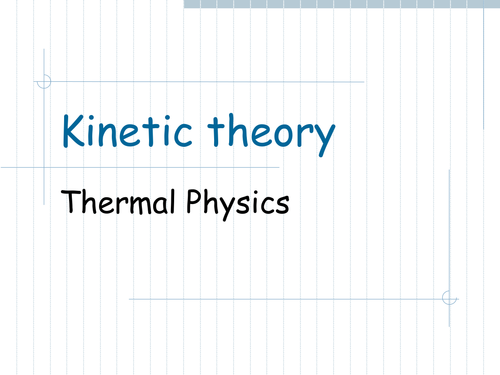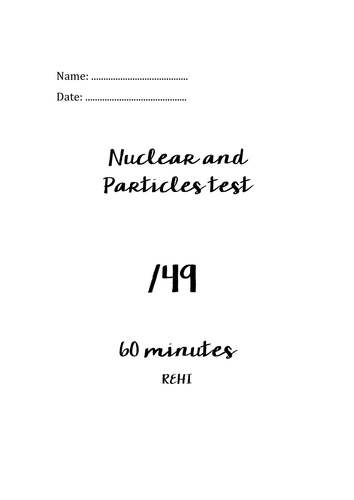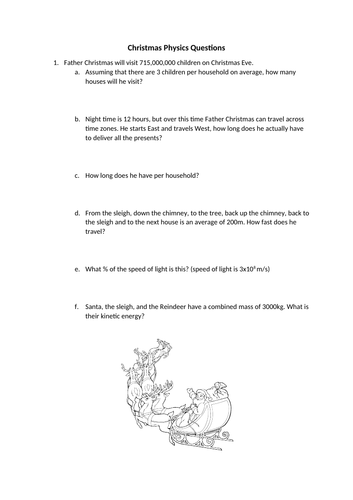
87Uploads
60k+Views
11k+Downloads
All resources

Simple Harmonic Motion test OCR A level Physics KS5
This is a 60 minute assessment made up of past paper questions from the OCR Physics A - H158, H558 course.
A level Physics topic questions.

Brain structure using an fMRI
Students read ‘medical notes’ on a patient after having an MRI scan, and use it to identify the parts of the brain.
This is to help students understand how MRIs are used to study the brain.

Le Chatelier's Principle
A worksheet on Le Chatelier's principle. Students have to describe what the diagrams show.

Hubble's law and the Redshift equation
A worksheet allowing pupils to calculate recessional velocity using the change in wavelength of spectral lines from stars.
This focuses on using the v/c = change in wavelength / wavelength equation.
After answering the 5 questions, pupils can conclude that the more distant the galaxy, the faster it is moving, which makes a great introduction to redshift and the Big Bang Theory.
There is an extension task to plot the recessional velocity against distance, calculate Hubble’s constant and calculate the age of the Universe.
If calculated correctly, pupils should conclude that the Universe is 13.8 billion years old.
Answers included.
The extension task is a great way to stretch and challenge the most able at GCSE, while the main task allows weaker pupils to practice using the Doppler shift redshift equation.
This could also act as a nice task for A-level pupils, studying Hubble’s law.

Kinetic theory of gases derivation
A powerpoint working through the derivation of pressure and kinetic theory equation of gases.
This can be quite complex, so the powerpoint works through step by step to make this easier.

Mass defect and binding energy
My lesson on mass defect and binding energy.
Talks them through the equation and how to use it.

Nuclear and Particle Physics test OCR KS5 A level
This is a 60 minute assessment made up of past paper questions from the OCR Physics A - H158, H558 course.

Energy and Electricity word loop game
Give each student a card. Each card has an answer at a the top, and a question at the bottom. One student reads out their question, and whoever has the answer reads out the answer and the next question. Keep going until you get back to the first student.
This is a great plenary, or starter for the next lesson.
Alternatively, Give the whole pack to one student, and see if they can match them all up to make a big circle.
This one is for the KS3/GCSE Physics Energy and Electricity topic.

Balancing forces
A couple of worksheets on balancing forces.
students label on the forces, and their names. They decide whether the forces are balanced, and if the object is accelerating.

Famous scientists posters
12 posters including pictures and quotes from different scientists.
I hand these out to students so that they can add information about the scientist around the quote, then laminate and display.
Lots of female scientists included, of course!

Braking forces worksheet - Work done against friction
A worksheet on braking forces. These reinforce the Work done equation as pupils calculate the stopping distance for cars moving at different speeds.
There are also some questions on where the energy goes and the affect of speed on braking distance.
Answers are also included.

Simple Harmonic Motion SHM definitions pendulum bob
Student cut out and create a pendulum bob on cardboard, then fill in the definitions to help them remember everything they need to know about pendulums!

Latent heat of fusion
My lesson on latent heat of fusion. Talks students through this, and includes some questions

Ideal gas law introduction
My lesson on ideal gas laws.
Includes Charles and Boyles.
I usually work through the practicals first, then use this at the end.

Particle guess who
Classic Guess who game but with subatomic particles.
Students can practise using key terms like baryon, meson, hadron, lepton, anti-matter, charge, quark etc

Where in space am I?
A worksheet on gravity and weight.
This includes a technician guide. Students weigh different objects which are labelled with their mass. They then try and work out which planet they are on using the W=mg Weight, mass, gravitational field strength equation.

Christmas Worksheet Science: Physics: Energy and Electricity
Some Christmas questions based on Physics knowledge, with answers.
This includes questions on:
Speed equation
Electrical power
Voltage, current and resistance
GPE
KE
Work done
Thermal energy transfers
Designed for Year 10 or 11.
Merry Christmas!




















